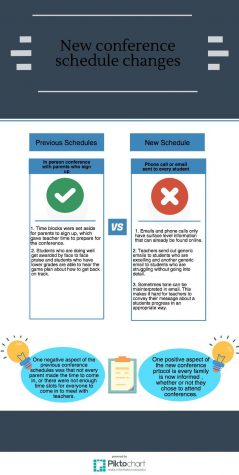New conference format provides parents with personalized communication
March 31, 2017

“For the past several years, our secondary schools have held both fall and winter conferences. The traditional format of five minute conferences has been less than desirable for many families. In response to your feedback, we will be trying a new format to share student progress information with families this winter,” Principal Robert Bach said in a letter to parents.
The new conference schedule is a complete remodel from the way they have been done in previous years and will prove to be more beneficial to everyone involved. Now, teachers send an email or phone call to their student’s parents about the student’s progress in the class and a summary of what will happen in-class in the upcoming months. Only if the students is “struggling” or parents send a request, do the teachers have to send personalized emails about the student’s standing in class.
With this new format for parent-teacher conferences, teachers spend about the same amount time on conferences. However, the information that is exchanged can be more in-depth and personalized for every student.
“Our expectations are for a total of eight hours of time dedicated to reaching out to and meeting with families and students in both formats. It’s part of our contracts. Until we’ve gone through this new process once, though, I can’t say for sure if I will be able to do it in eight hours or if it will take more time than that,” Spanish teacher Rebecca Skogen said.
Another benefit to the new format is that more time can be spent on struggling students. Teachers can send detailed emails to students who are failing and suggest ways the parents can help.
“We need to come up with meaningful feedback that isn’t just grades. In meeting with desired families for two sections of English I will end up going past the allotted 8 hours,” English teacher Andrew Smith said.
Parents who have jobs which go into the evening cannot always make it to the allotted time for conferences. With the new format, these parents can still get feedback about their child when they have time to sit down and really read the email. If this parent wants more information, they can schedule an appointment or call the teacher.
“I believe this flexible format will be helpful for families who in the past have not been able to attend on our traditional conference nights due to extracurricular activities, family obligations, or other commitments. Not only does this give parents & guardians more flexibility, but I hope it will make it easier for our students to potentially attend their own conferences, which makes those meetings so much more productive and beneficial for everyone,” Skogen said.
Although the new format has many benefits, there are some downfalls to it as well.
“I think it’s dumb. Parents can just check skyward and it’s unnecessary work for teachers,” junior Holly Ringsak said.
There is less accountability for teachers unless they are contacted by their parents to write detailed and informational emails. The parents of students on the bubble (students on the edge of failing) are not necessarily informed about their child’s struggles because the teachers do not have to say anything if the student is not failing. However, every parent has access to their child’s Skyward and if the parent looked and knew their child was on the bubble, all they have to do is send the teacher for a request to know more details about the child’s behavior and academic performance in a specific class.
More teachers should make a point to know their child’s grades before conferences so they know which teachers they should request to talk to one-on-one. This is how the new format is supposed to work so the process is easier on everyone involved. Parents and students must take the initiative with the new format in order to get everything they need to improve their performance in the classroom.
Megan Karnuth • May 7, 2017 at 10:59 pm
Strong story, I wrote on the same topic and wanted to read yours to see the differences in angles. I really like how you set up your lead with a strong quote from Mr. Bach. I also like your point of view on the benefits to this new strategy from different teachers around the building. You also have a strong call to action concluding your story, great work!